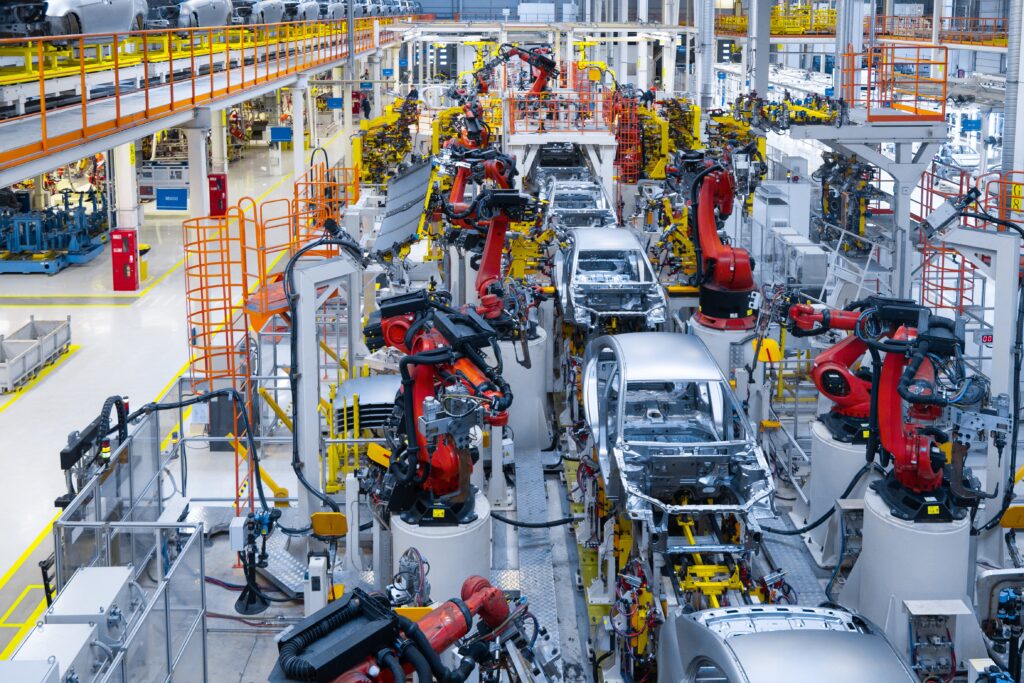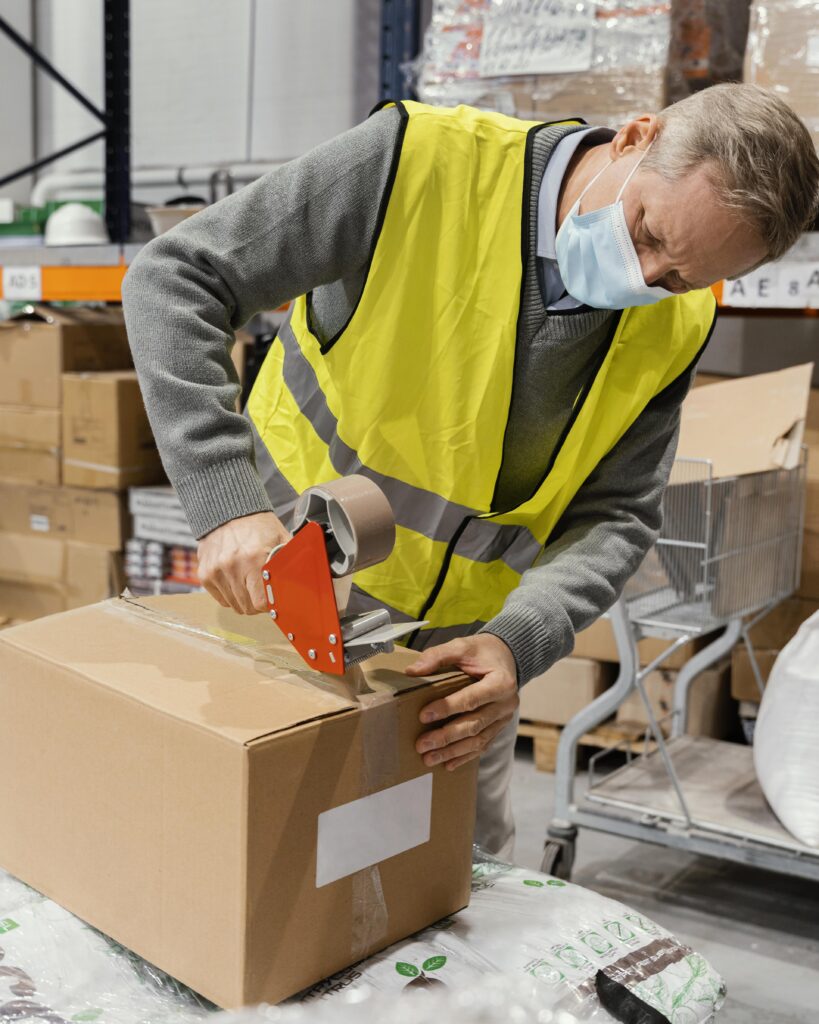How SaaS Solutions Are Transforming Chemical Safety and Waste Management

How SaaS Solutions Are Transforming Chemical Safety and Waste Management The chemical industry plays a critical role in modern life, driving innovation in healthcare, energy, agriculture, and manufacturing. However, it also faces intense scrutiny due to the risks associated with chemical safety and waste management. From hazardous material handling to regulatory compliance, companies must navigate complex challenges to protect workers, communities, and the environment. In this digital era, Software-as-a-Service (SaaS) solutions are emerging as powerful tools to transform how chemical companies manage safety and sustainability. By replacing traditional manual processes with cloud-based platforms, manufacturers can improve compliance, reduce risks, streamline reporting, and build more sustainable operations. This article explores the role of SaaS in reshaping chemical safety and waste management, the benefits it offers, and the future it holds for the industry. The Challenges of Chemical Safety and Waste Management Before exploring how SaaS is transforming the sector, it’s important to understand the pain points chemical manufacturers face: Complex Regulatory Landscape: Global frameworks such as REACH (EU), TSCA (U.S.), and GHS require extensive documentation and reporting. Data Overload: Managing safety data sheets (SDS), hazard classifications, and waste records across thousands of chemicals is overwhelming. Worker Safety Risks: Exposure to hazardous substances, inadequate training, or improper handling can cause accidents and long-term health issues. Waste Disposal Issues: Improper treatment of chemical waste can harm the environment, attract penalties, and damage brand reputation. Supply Chain Transparency: Companies must ensure not just their own compliance but also that of suppliers and distributors. Traditional approaches—spreadsheets, paper records, and siloed systems—are no longer adequate. The industry needs scalable, real-time solutions to meet rising demands for safety and sustainability. How SaaS Solutions Are Driving Change 1. Centralized Data Management SaaS platforms offer cloud-based systems that centralize all chemical safety and waste data. Instead of maintaining fragmented spreadsheets, companies can: Store and access Safety Data Sheets (SDS) in real time. Track hazardous materials throughout their lifecycle. Standardize reporting across global sites. Centralization ensures consistency, accuracy, and transparency, reducing the risk of errors in compliance submissions. 2. Real-Time Compliance Automation Regulatory compliance often involves tedious reporting and monitoring. SaaS solutions use automation to simplify the process: Auto-updating chemical classifications when global regulations change. Generating compliance reports instantly across jurisdictions. Flagging non-compliant chemicals before shipment. This not only saves time but also minimizes penalties and delays due to reporting errors. 3. Enhanced Worker Safety SaaS tools provide digital training modules, mobile apps, and real-time alerts to improve workplace safety: Workers can access updated safety protocols on their devices. Supervisors can track training completion and safety audits. Incident reporting can be streamlined through mobile platforms. By making safety information more accessible, SaaS reduces the likelihood of accidents and enhances occupational safety compliance. 4. Waste Management Optimization Chemical waste management is one of the most challenging aspects of sustainability. SaaS solutions help companies: Track waste generation at each stage of production. Automate disposal scheduling with certified waste handlers. Generate sustainability reports on recycling and reuse initiatives. Identify opportunities to reduce waste through analytics. This data-driven approach supports compliance with environmental regulations while also reducing costs. 5. Supply Chain Visibility SaaS platforms offer end-to-end visibility across the chemical supply chain. Companies can: Verify supplier compliance with safety and waste management standards. Monitor logistics partners for safe transport of hazardous materials. Trace raw materials back to their source for transparency. This visibility ensures that compliance extends beyond internal operations to the entire value chain. 6. Data Analytics and Predictive Insights Advanced SaaS solutions leverage AI and machine learning to provide predictive insights: Forecast potential safety risks before incidents occur. Identify trends in waste generation and disposal inefficiencies. Optimize resource usage for sustainability goals. These insights allow manufacturers to move from reactive compliance to proactive risk management. Benefits of SaaS in Chemical Safety and Waste Management The adoption of SaaS solutions offers chemical companies a range of benefits: Scalability: Cloud-based systems grow with business needs without requiring heavy IT infrastructure. Cost Efficiency: Reduced administrative overhead and fewer compliance penalties save money. Improved Accuracy: Automation eliminates human error in regulatory reporting. Faster Decision-Making: Real-time dashboards and analytics enable quicker responses to safety risks. Global Consistency: Standardized compliance across regions simplifies multi-country operations. Sustainability: Better waste tracking and recycling support corporate ESG commitments. Real-World Applications Hazard Communication: Multinational chemical firms use SaaS to manage thousands of SDS across dozens of markets. Incident Management: Cloud platforms allow immediate reporting and investigation of workplace safety incidents. Waste Tracking: SaaS tools monitor hazardous waste movement from generation to certified disposal, ensuring full traceability. Regulatory Updates: Platforms auto-update compliance requirements based on changes in local and global laws. These applications show how SaaS is becoming the backbone of compliance and sustainability strategies. The Future of SaaS in the Chemical Industry Looking ahead, SaaS will continue to evolve and play an even greater role in chemical safety and waste management: AI-Powered Compliance: Predictive analytics will anticipate risks and recommend preventive actions. Blockchain for Traceability: Immutable records will enhance trust across global supply chains. Integration with IoT: Connected sensors will provide real-time emissions and waste data directly into SaaS platforms. Customized ESG Reporting: SaaS will support detailed sustainability disclosures for investors and regulators. By 2030, SaaS solutions are expected to become the standard in chemical safety and waste management, enabling manufacturers to balance compliance, profitability, and sustainability. Conclusion The chemical industry faces immense challenges in ensuring safety, managing waste, and meeting global compliance standards. Traditional approaches are no longer sufficient in a world where regulations, sustainability demands, and stakeholder expectations are constantly rising. SaaS solutions are transforming chemical safety and waste management by offering centralized data, real-time compliance, supply chain transparency, and predictive analytics. For manufacturers, adopting these tools is not just about keeping up with regulations—it’s about building safer workplaces, reducing environmental impact, and driving sustainable growth. In an era where digital transformation is reshaping every industry, SaaS stands out as the future-ready solution for chemical companies aiming to stay competitive and responsible. How SaaS Solutions Are Transforming Chemical Safety
Emerging Trends in Chemical Regulatory Reporting for 2025 and Beyond

Emerging Trends in Chemical Regulatory Reporting for 2025 and Beyond. The chemical industry is entering a transformative phase where regulatory reporting is becoming increasingly complex, data-driven, and sustainability-focused. For chemical manufacturers, keeping pace with evolving compliance requirements is not just a legal obligation—it is essential for market access, reputation, and long-term growth. As we step into 2025 and beyond, emerging trends in chemical regulatory reporting are reshaping how companies collect, manage, and disclose compliance information. Driven by stricter global regulations, digital transformation, and growing environmental, social, and governance (ESG) expectations, the industry must adapt rapidly to remain competitive. In this article, we explore the key trends influencing chemical regulatory reporting, the challenges manufacturers face, and strategies to prepare for the future. Why Regulatory Reporting Matters in the Chemical Industry Chemical products affect nearly every aspect of modern life, from healthcare and agriculture to construction and electronics. But the production and use of chemicals also pose risks to human health and the environment. To minimize these risks, governments and international bodies enforce strict chemical safety regulations. Regulatory reporting ensures that manufacturers: Provide accurate data on chemical composition, hazards, and safe use. Align with frameworks like REACH (Europe), TSCA (U.S.), and GHS (Globally Harmonized System). Demonstrate compliance with sustainability and ESG requirements. Build trust with regulators, investors, and customers. Failure to comply can lead to penalties, restricted market access, reputational damage, and supply chain disruptions. Thus, staying ahead of regulatory reporting trends is critical for chemical manufacturers. Key Trends Shaping Chemical Regulatory Reporting in 2025 and Beyond 1. Digital Transformation and Automation The days of manual data collection and paper-based submissions are ending. Regulatory authorities worldwide are shifting toward digital-first reporting systems that require chemical companies to adopt automation and advanced data management tools. AI and Machine Learning will streamline hazard classification and predictive risk assessments. Blockchain will enhance traceability across supply chains, ensuring data authenticity. Cloud-based compliance platforms will centralize reporting, reducing duplication of effort. This digital shift will not only improve accuracy but also allow regulators to analyze compliance data in real time. 2. Greater Global Harmonization For decades, manufacturers have struggled with the challenge of complying with fragmented regulations across markets. However, global efforts toward harmonization are gaining momentum. The Globally Harmonized System (GHS) continues to expand, standardizing labeling and classification. More countries are aligning with frameworks like REACH and TSCA. Regional trade agreements increasingly require mutual recognition of compliance standards. By 2025, we can expect regulatory frameworks to become more aligned, reducing complexity for manufacturers exporting to multiple regions. 3. ESG and Sustainability Integration Regulatory reporting is no longer limited to chemical safety—it now intersects with sustainability and ESG performance. Investors, regulators, and customers expect transparency in areas such as: Carbon emissions and energy use Waste management and recycling practices Supply chain labor standards Product life-cycle assessments Emerging frameworks like the Corporate Sustainability Reporting Directive (CSRD) in Europe are reshaping how chemical companies disclose non-financial data. For manufacturers, this means integrating ESG metrics into compliance reporting will be mandatory rather than optional. 4. Real-Time and Continuous Reporting Traditional compliance reporting often involved annual or periodic submissions. Moving forward, regulators are embracing real-time or continuous reporting models to enhance oversight. Internet of Things (IoT) devices and sensors will enable live monitoring of emissions and discharges. Continuous data feeds will provide regulators with near-instant updates on compliance performance. This will push companies to adopt dynamic reporting systems instead of static reports. Real-time reporting increases accountability but also demands advanced infrastructure and strong internal processes. 5. Rising Focus on Supply Chain Transparency As chemical supply chains grow increasingly global and complex, regulatory agencies are demanding greater transparency across the entire value chain. Manufacturers will be required to report not only on their operations but also on: Supplier compliance with safety and ESG standards. Traceability of raw materials, especially hazardous substances. Responsible sourcing practices, including conflict minerals and ethical labor. This trend will require close collaboration with suppliers, more frequent audits, and advanced digital tools to track compliance across multiple tiers of the supply chain. 6. AI-Powered Risk Prediction Artificial Intelligence is emerging as a game-changer in regulatory compliance. In the coming years, regulators and companies alike will use AI to: Predict potential compliance risks before they occur. Identify emerging chemical hazards through big data analysis. Automate classification and labeling under frameworks like GHS. AI-driven tools will help manufacturers reduce costs, improve accuracy, and minimize regulatory risks. 7. Increased Regulatory Scrutiny on Emerging Chemicals New classes of chemicals, such as PFAS (per- and polyfluoroalkyl substances), nanomaterials, and bio-based chemicals, are under heightened scrutiny. Regulators are expanding requirements for testing, reporting, and disclosure. Manufacturers must stay ahead by: Monitoring regulatory updates closely. Conducting advanced safety studies on emerging chemicals. Preparing for stricter reporting obligations on innovative materials. Challenges Manufacturers Will Face While these trends create opportunities for more transparent and sustainable practices, they also introduce challenges: High Implementation Costs: Adopting digital platforms, IoT devices, and AI tools requires major investments. Data Overload: Managing large volumes of real-time compliance data can overwhelm organizations. Talent Gap: Companies need skilled compliance professionals who understand both technology and regulations. Supplier Coordination: Ensuring ESG and safety compliance across global supply chains is a complex task. Strategies to Prepare for the Future To remain competitive in 2025 and beyond, chemical manufacturers should take proactive steps: Invest in Technology: Adopt digital compliance management systems, IoT sensors, and AI tools to stay ahead of reporting requirements. Enhance Collaboration: Work closely with suppliers, distributors, and industry associations to share compliance data and best practices. Integrate ESG into Reporting: Ensure that sustainability metrics are embedded into compliance frameworks from the ground up. Upskill Workforce: Train employees in regulatory reporting, data analytics, and ESG management. Adopt a Proactive Mindset: Instead of reacting to new regulations, build flexible systems that can adapt to emerging requirements. Looking Ahead The future of chemical regulatory reporting will be defined by digital transformation, ESG integration, and greater global harmonization. Companies that embrace these changes will not only meet
The Role of ESG in Building a Sustainable Chemical Supply Chain

The Role of ESG in Building a Sustainable Chemical Supply Chain The chemical industry is at the heart of global progress, powering sectors such as healthcare, agriculture, energy, and manufacturing. Yet, it also faces increasing scrutiny due to its environmental footprint, safety risks, and governance challenges. Today, Environmental, Social, and Governance (ESG) principles have become a driving force in transforming how chemical companies operate and manage their supply chains. Building a sustainable chemical supply chain is no longer a choice—it’s a necessity. Governments, investors, and customers demand greater accountability, transparency, and responsibility from manufacturers. Integrating ESG practices into supply chain management ensures not only compliance with regulations but also long-term resilience, efficiency, and reputation. Why ESG Matters in the Chemical Supply Chain The chemical industry is resource-intensive and often linked to environmental risks such as emissions, waste, and hazardous materials handling. Additionally, complex global supply chains expose manufacturers to challenges around worker safety, ethical sourcing, and governance. By embedding ESG principles into operations, companies can: Reduce Environmental Impact: Lower emissions, improve waste management, and adopt cleaner technologies. Protect Workers and Communities: Ensure safe workplaces, fair labor practices, and community engagement. Enhance Transparency: Build trust with stakeholders through ethical governance and responsible reporting. Improve Market Competitiveness: Meet global sustainability standards and appeal to ESG-conscious investors and customers. Key ESG Challenges in Chemical Supply Chains While the benefits of ESG integration are clear, chemical manufacturers face significant challenges in execution. Some of the most pressing issues include: 1. Environmental Challenges The chemical industry consumes vast amounts of energy and water, often resulting in greenhouse gas emissions, effluents, and waste. Meeting environmental compliance requires companies to adopt clean technologies, track emissions, and align with global climate goals such as net-zero targets. 2. Social Responsibility Issues Worker health and safety remain a central concern. Handling hazardous substances requires strict adherence to protocols, training, and protective equipment. Beyond internal operations, companies must ensure their suppliers also follow ethical labor practices, avoid child labor, and prioritize worker well-being. 3. Governance and Transparency Governance challenges include data management, regulatory reporting, and risk management across complex global networks. Lack of transparency in supplier practices can expose companies to reputational and legal risks. Stakeholders demand greater visibility into sourcing, production, and distribution practices. 4. Supply Chain Complexity Most chemical manufacturers source raw materials from multiple countries. Ensuring that all suppliers comply with ESG standards is difficult, especially when dealing with regions with weaker enforcement or limited infrastructure for compliance. The Role of ESG in Driving Sustainable Supply Chains To overcome these challenges, manufacturers must view ESG not as a box-ticking exercise but as a strategic framework for long-term value creation. Here’s how ESG principles shape sustainable chemical supply chains: 1. Environmental Stewardship Green Chemistry: Adopting safer, eco-friendly raw materials and reducing reliance on hazardous chemicals. Energy Efficiency: Implementing renewable energy solutions and reducing carbon footprints across facilities. Waste Reduction: Embracing circular economy models—recycling, reusing by-products, and minimizing waste generation. Sustainable Logistics: Optimizing transportation routes, using energy-efficient fleets, and adopting smart packaging to reduce emissions. 2. Social Responsibility Worker Safety: Providing training, safety equipment, and monitoring systems to protect employees from hazardous exposure. Fair Labor Practices: Ensuring ethical working conditions across the supply chain, including suppliers and contractors. Community Engagement: Supporting local communities through education, healthcare, and environmental initiatives. Diversity and Inclusion: Building diverse workforces and leadership teams to foster innovation and fairness. 3. Strong Governance Regulatory Compliance: Aligning with international standards such as REACH, GHS, and OSHA. Transparency: Implementing systems for traceability, supplier audits, and clear ESG reporting. Risk Management: Identifying, assessing, and mitigating risks across supply chains through digital monitoring tools. Accountability: Establishing ESG-focused leadership and governance boards to ensure continuous progress. Benefits of ESG Integration in the Chemical Supply Chain When chemical companies integrate ESG effectively, the results go beyond compliance—they build resilient, future-ready supply chains. Some key benefits include: Improved Reputation: Demonstrates responsibility, enhancing trust among regulators, customers, and investors. Operational Efficiency: Reducing waste, energy use, and resource consumption lowers costs in the long run. Market Access: Many global buyers now require ESG compliance as a prerequisite for partnerships. Investor Confidence: ESG performance is increasingly linked to funding opportunities and financial stability. Innovation: A focus on sustainability encourages the development of new, eco-friendly products and processes. Practical Steps for Manufacturers To make ESG integration actionable, chemical manufacturers can adopt the following strategies: 1. Develop an ESG Roadmap Establish clear goals for environmental performance, social responsibility, and governance. This roadmap should align with both regulatory requirements and stakeholder expectations. 2. Implement Digital Tools Use technology platforms for supply chain traceability, emissions monitoring, and compliance reporting. Data-driven insights make it easier to identify gaps and ensure continuous improvement. 3. Collaborate Across the Supply Chain Engage with suppliers and distributors to establish shared ESG goals. Regular audits, certifications, and training programs can raise standards across the entire chain. 4. Invest in Innovation Prioritize R&D in green chemistry, renewable energy, and sustainable packaging to reduce long-term risks and enhance competitiveness. 5. Report Transparently Publish ESG reports that detail sustainability metrics, compliance performance, and progress toward goals. Transparency builds credibility with stakeholders. The Future of ESG in the Chemical Industry Looking ahead, ESG will continue to play a pivotal role in shaping the future of the chemical industry. Key trends include: Global Harmonization: Growing alignment of international standards will simplify compliance across markets. Digital Transformation: AI, blockchain, and IoT will revolutionize traceability and compliance monitoring. Investor Pressure: ESG scores will increasingly influence access to capital and business partnerships. Customer Demand: Consumers will favor companies with strong sustainability credentials, creating competitive advantages for ESG leaders. The companies that proactively embed ESG into their supply chain strategy will be best positioned to thrive in a fast-changing, sustainability-driven world. Conclusion The role of ESG in building a sustainable chemical supply chain is clear—it ensures compliance, enhances resilience, protects people and the planet, and strengthens long-term business performance. While challenges exist—ranging from regulatory diversity to supply chain complexity—the benefits of adopting ESG practices far
Global Chemical Safety Compliance Challenges Faced by Manufacturers

Global Chemical Safety Compliance Challenges Faced by Manufacturers The chemical industry is one of the world’s most dynamic and impactful sectors, fueling advancements in pharmaceuticals, agriculture, construction, energy, and countless other industries. However, with such broad influence comes a high degree of responsibility. Manufacturers must ensure that their products, processes, and operations comply with strict chemical safety regulations across different regions. The challenges of achieving and maintaining compliance are complex, often demanding significant resources, expertise, and continuous improvement. In this article, we explore the global chemical safety compliance challenges faced by manufacturers, their implications, and strategies to overcome them in today’s interconnected marketplace. The Rising Importance of Chemical Safety Compliance In recent years, regulatory frameworks around chemical safety have become increasingly stringent. Governments, international organizations, and industry bodies are tightening safety laws to protect workers, consumers, and the environment. At the same time, global stakeholders—ranging from investors to consumers—expect companies to demonstrate transparency, sustainability, and responsibility. Compliance is no longer optional. Non-compliance can result in: Hefty fines and legal action Supply chain disruptions Damage to brand reputation Environmental and health risks Barriers to entering global markets Thus, chemical manufacturers must align operations with international standards such as REACH (EU), OSHA (U.S.), GHS (Globally Harmonized System of Classification and Labelling of Chemicals), and local regulations in every market where they operate. Key Compliance Challenges for Manufacturers Despite the importance of compliance, manufacturers face several hurdles that make implementation difficult. These challenges often stem from the complex nature of chemical production and the evolving global regulatory landscape. 1. Diverse and Evolving Global Regulations One of the biggest obstacles is the sheer diversity of chemical safety regulations across countries. For example, compliance requirements in Europe under REACH differ from those in the United States under OSHA or the Toxic Substances Control Act. Manufacturers exporting to multiple countries must ensure their products meet each jurisdiction’s rules, often leading to duplication of effort and increased costs. Additionally, regulations are constantly evolving. Keeping up with changes—whether it’s stricter environmental emissions limits or new labeling requirements—requires constant monitoring and adaptation. 2. Data Management and Documentation Chemical safety compliance is heavily data-driven. Manufacturers must collect, validate, and maintain comprehensive information about: Chemical composition and properties Safety data sheets (SDS) Exposure scenarios Hazard classifications Packaging and labeling requirements Managing this data across thousands of products, suppliers, and geographies is a daunting task. Many manufacturers struggle with fragmented systems, manual processes, and inconsistent recordkeeping, making it difficult to provide accurate and timely compliance reports. 3. Worker Health and Safety Manufacturing and handling chemicals involve risks to workers, including exposure to hazardous substances, accidents, and long-term health impacts. Ensuring occupational safety requires: Proper training on handling hazardous materials Use of personal protective equipment (PPE) Emergency response protocols Regular monitoring of workplace air and water quality However, limited resources, inconsistent enforcement, and lack of awareness often create gaps in worker safety compliance, particularly for small and medium-sized enterprises (SMEs). 4. Supply Chain Complexity Modern supply chains are deeply interconnected, and manufacturers often rely on a wide network of raw material suppliers and distributors. Ensuring compliance across the supply chain is challenging because manufacturers must verify that upstream suppliers follow the same standards. If one supplier fails to provide accurate safety documentation or misclassifies a chemical, the entire chain can be exposed to regulatory and reputational risks. This challenge is magnified when sourcing from countries with weaker enforcement or limited infrastructure for compliance. 5. ESG and Sustainability Pressures Today, compliance is not limited to meeting minimum legal requirements. Stakeholders expect chemical manufacturers to go beyond compliance and embrace sustainability and ESG (Environmental, Social, and Governance) practices. This includes: Reducing carbon emissions Managing chemical waste responsibly Using renewable energy in production Reporting on sustainability metrics While beneficial in the long run, these additional requirements add layers of complexity and cost for manufacturers already stretched thin by regulatory compliance. 6. Cost and Resource Constraints For many manufacturers, especially SMEs, the financial and human resources required for compliance are overwhelming. Hiring compliance experts, investing in digital solutions, upgrading facilities, and conducting training programs all come with significant costs. Balancing profitability and compliance is a constant struggle, particularly in highly competitive markets where margins are slim. The Impact of Non-Compliance Failing to meet chemical safety compliance obligations can have severe consequences, including: Financial Penalties: Governments and regulatory bodies impose heavy fines on non-compliant companies. Operational Disruptions: Products may be banned, shipments delayed, or licenses revoked. Reputation Damage: Customers and partners lose trust in non-compliant companies. Legal Liabilities: Non-compliance can lead to lawsuits, especially in cases of environmental or worker harm. Global Market Access Restrictions: Without compliance, manufacturers may be barred from exporting to key markets like the EU or U.S. Thus, compliance must be viewed not just as a legal requirement but as a strategic business imperative. Strategies to Overcome Compliance Challenges Despite the difficulties, manufacturers can take proactive steps to improve compliance and reduce risks. Some strategies include: 1. Invest in Digital Compliance Solutions Advanced software platforms can help manage chemical data, automate regulatory reporting, and monitor global changes. A centralized compliance management system reduces errors, improves transparency, and ensures timely updates. 2. Strengthen Training and Safety Programs Continuous training for employees on safe chemical handling, waste management, and emergency response improves workplace safety and reduces compliance risks. Tailored programs ensure workers understand both global and local standards. 3. Collaborate with Supply Chain Partners Manufacturers should establish strong partnerships with suppliers and require compliance certifications and transparent data sharing. Regular audits and third-party verifications can further strengthen supply chain accountability. 4. Engage ESG and Sustainability Practices By integrating sustainability into operations, manufacturers not only improve compliance but also enhance competitiveness and reputation. For example, adopting green chemistry principles or circular economy models can reduce long-term risks and costs. 5. Leverage Third-Party Expertise Partnering with specialized consultants, compliance auditors, or industry associations helps manufacturers stay updated on regulatory changes and implement best practices. SMEs, in particular, can benefit from outsourcing compliance tasks to reduce internal burdens.
Workforce Training for the Future of Mobility

Workforce Training for the Future of Mobility The automotive sector is in the midst of a speeding change with the advent of electric vehicles (EVs), autonomous driving technology, connected cars, and sustainable manufacturing. In order to remain competitive, automotive firms need to get their workforce ready for this future of mobility. They need training programmes on new technologies, ESG compliance, and digital tools to create a skilled, resilient workforce. At POSITIIVPLUS, we assist vehicle manufacturers with ESG-led workforce development programs that map abilities against the changing requirements of mobility. This blog discusses why workforce training is important and how to ready workers for the next generation in the automotive industry. Why Workforce Training is Important for Future Mobility Technological Changes EV power trains, AI-based vehicle systems, and connected technologies require new technical capabilities from workers at all levels. ESG and Sustainability Objectives Trained personnel support manufacturers in achieving carbon reduction objectives, minimizing waste, and being compliant. Resilience in Operations Trained staff can learn new processes, minimizing downtime, enhancing quality, and maximizing production efficiency. Customer Demands With the transition of consumer demand to sustainable and technology-led vehicles, trained personnel deliver consistent quality and reliability. Principal Workforce Training Areas in Automotive Electric Vehicle Systems Training Build battery assembly, charging infrastructure, and EV safety standard skills. Digital and Data Literacy Educate employees to employ real-time monitoring software, predictive analytics, and digital twins to maximize operations. Automation and Robotics Train personnel to collaborate with robotics and automated production systems safely and effectively. Sustainable Manufacturing Practices Educate resource efficiency, waste reduction, and carbon management methodologies to meet ESG compliance requirements. Cross-Functional Skills Development Foster collaboration between engineering, IT, and operations to create a resilient and future-capable workforce. Conclusion: Creating a Talented Workforce for the Future The mobility of the future needs a workforce that is sustainable, skilled, and compatible with technological change as well as sustainability objectives. Automotive manufacturers can future-proof their operations, minimize risks, and provide high-quality vehicles that satisfy changing customer expectations by investing in training programs today. At POSITIIVPLUS, we assist automobile organizations to develop and implement solutions for workforce training that equip workers for future mobility challenges and opportunities. Future-proof your employees. Learn our ESG-based training solutions for the automotive sector at POSITIIVPLUS. Workforce Training for the Future of Mobility hardik • September 27, 2025 • Automotives • No Comments EV Manufacturing and Carbon Reduction Roadmaps The transition to electric vehicles (EVs) is revolutionizing the automotive sector. As EVs hold the promise … EV Manufacturing and Carbon Reduction Roadmaps hardik • September 27, 2025 • Automotives • No Comments EV Manufacturing and Carbon Reduction Roadmaps The transition to electric vehicles (EVs) is revolutionizing the automotive sector. As EVs hold the promise … IATF 16949 Compliance Made Simple in Automotive Manufacturing hardik • September 27, 2025 • Automotives • No Comments IATF 16949 Compliance Made Simple in Automotive Manufacturing Obtaining compliance with IATF 16949, the worldwide quality management standard for the automotive market, … Reducing Automotive Recalls with Data Manager hardik • September 27, 2025 • Automotives • No Comments Reducing Automotive Recalls with Data Manager Automotive recalls are expensive, harmful to brand image, and disruptive to production timelines. No matter the …
EV Manufacturing and Carbon Reduction Roadmaps

EV Manufacturing and Carbon Reduction Roadmaps The transition to electric vehicles (EVs) is revolutionizing the automotive sector. As EVs hold the promise of reduced emissions for end-users, producers need to mitigate the carbon impact of manufacturing as well. Right from battery fabrication to paint operations and supply chain logistics, minimizing carbon emissions throughout the manufacturing process is imperative for ESG (Environmental, Social, and Governance) and sustainable long-term existence. At POSITIIVPLUS, we assist vehicle makers in creating carbon reduction roadmaps for the production of electric vehicles through real-time information, predictive insights, and process improvement. This blog discusses how to create low-carbon EV manufacturing facilities. Why Carbon Reduction Is Important in EV Production Compliance with Regulations Governments across the globe are imposing stringent emissions regulations as well as reporting requirements on automotive manufacturing. ESG and Investors’ Expectations Investors and stakeholders increasingly value low-carbon operations as a sustainability and long-term profitability metric. Cost Savings and Operational Efficiency Efficient processes save resources and electricity, decreasing production costs. Brand Reputation EV buyers prefer EVs produced with sustainable methods, enhancing brand credibility and market competitiveness. Carbon Reduction Strategies in EV Production Energy Optimization Install smart energy management systems to track electricity consumption in real-time, cut peak loads, and shift to renewable power sources. Sustainable Supply Chain Management Partner with suppliers who have a focus on low-carbon materials, recycling, and energy-efficient logistics to cut upstream emissions. Process Innovation Implement low-emission manufacturing processes in battery assembly, painting, stamping, and other high-impact operations. Predictive Maintenance and Real-Time Monitoring Avoid unplanned downtime and wasteful operations with data-driven insights, minimizing energy waste and carbon emissions. Carbon Accounting and Reporting Measure, track, and report carbon footprint accurately with digital tools across production sites, enabling ESG compliance. Conclusion: Driving Sustainability in EV Manufacturing Carbon emissions reduction in EV manufacturing is not only essential for regulatory compliance but also to ensure operational efficiency, cost competitiveness, and brand reputation. Through the use of real-time data, green supply chain strategies, and process innovation, automobile companies can ensure low-carbon operations that are aligned with ESG principles. We at POSITIIVPLUS assist EV manufacturers in creating executable carbon reduction roadmaps that maximize efficiency, lower environmental footprint, and enhance sustainability credentials. Speed up your EV factory’s carbon reduction journey. Discover our ESG-led solutions at POSITIIVPLUS. EV Manufacturing and Carbon Reduction Roadmaps hardik • September 27, 2025 • Automotives • No Comments EV Manufacturing and Carbon Reduction Roadmaps The transition to electric vehicles (EVs) is revolutionizing the automotive sector. As EVs hold the promise … IATF 16949 Compliance Made Simple in Automotive Manufacturing hardik • September 27, 2025 • Automotives • No Comments IATF 16949 Compliance Made Simple in Automotive Manufacturing Obtaining compliance with IATF 16949, the worldwide quality management standard for the automotive market, … Reducing Automotive Recalls with Data Manager hardik • September 27, 2025 • Automotives • No Comments Reducing Automotive Recalls with Data Manager Automotive recalls are expensive, harmful to brand image, and disruptive to production timelines. No matter the … Programs That Build Greener Operations in Packaging hardik • September 26, 2025 • Packaging • No Comments Programs That Build Greener Operations in Packaging Greener packaging is no longer a choice—it’s a business necessity. To get to greener operations, …
IATF 16949 Compliance Made Simple in Automotive Manufacturing

IATF 16949 Compliance Made Simple in Automotive Manufacturing Obtaining compliance with IATF 16949, the worldwide quality management standard for the automotive market, is essential for companies that want to guarantee product quality, safety, and reliability. But achieving and maintaining compliance in production lines, suppliers, and various facilities can become overwhelming. At POSITIIVPLUS, we offer ESG-based tools and solutions that make it easy to comply with IATF 16949, enabling automotive manufacturers to streamline processes, enhance quality control, and lower operational risks. In this blog, we discuss ways to make compliance efficient and effective. Why IATF 16949 Compliance Is Important Ensures Product Quality and Safety Compliance ensures vehicles and parts adhere to high-quality standards, lowering defects and recalls. Enhances Operational Efficiency Organized procedures and well-documented steps enhance workflow, eliminate mistakes, and maximize the use of resources. Enhances Supplier Relationships Suppliers who meet IATF 16949 standards are more credible, producing consistent material quality throughout the supply chain. Facilitates ESG and Regulatory Objectives Quality management compliance supports sustainability initiatives, minimizes waste, and maximizes environmental responsibility. How to Streamline IATF 16949 Compliance Electronic Quality Management Systems (QMS) Utilize QMS software to centralize documentation control, track corrective action, and monitor compliance across plants. Real-Time Data Monitoring Monitor manufacturing processes and supplier performance in real-time to detect possible non-conformities before they reach critical levels. Standardized Training Programs Train personnel on IATF 16949 requirements, process standards, and ESG best practices to ensure uniform implementation. Supplier Audits and Assessments Periodically review supplier adherence to ensure quality throughout the supply chain and minimize risks of faulty components. Feedback Loops and Continuous Improvement Take corrective and preventive measures (CAPA) on the basis of performance metrics to ensure long-term compliance. Conclusion: Making Compliance Straightforward IATF 16949 compliance is not always easy. Automotive manufacturers can use digital tools, real-time monitoring, and systematic training to achieve high-quality standards, minimize recalls, and align with ESG goals. At POSITIIVPLUS, we make IATF 16949 compliance easier with integrated solutions that enhance quality, process efficiency, and sustainability. Simplify IATF 16949 compliance. Find our automotive ESG and quality management solutions at POSITIIVPLUS. IATF 16949 Compliance Made Simple in Automotive Manufacturing hardik • September 27, 2025 • Automotives • No Comments Reducing Automotive Recalls with Data Manager Automotive recalls are expensive, harmful to brand image, and disruptive to production timelines. No matter the … Reducing Automotive Recalls with Data Manager hardik • September 27, 2025 • Automotives • No Comments Reducing Automotive Recalls with Data Manager Automotive recalls are expensive, harmful to brand image, and disruptive to production timelines. No matter the … Programs That Build Greener Operations in Packaging hardik • September 26, 2025 • Packaging • No Comments Programs That Build Greener Operations in Packaging Greener packaging is no longer a choice—it’s a business necessity. To get to greener operations, … Sustainable Packaging Production Without Complexity hardik • September 26, 2025 • Packaging • No Comments Sustainable Packaging Production Without Complexity The packaging market is coming under mounting pressure to provide sustainable solutions. Consumers, regulators, and brands are …
Reducing Automotive Recalls with Data Manager

Reducing Automotive Recalls with Data Manager Automotive recalls are expensive, harmful to brand image, and disruptive to production timelines. No matter the reason from component malfunction to manufacturing defects or compliance troubles, recalls not only undermine consumer confidence but also raise operating costs substantially. In a world where data-driven analytics are revolutionizing sectors, auto manufacturers require cutting-edge solutions to avoid recalls even before they occur. At POSITIIVPLUS, our Data Manager solution provides real-time monitoring and analytics to identify potential defects, ensure compliance, and streamline automotive production. This blog explores how leveraging data effectively can reduce recalls, improve safety, and enhance ESG (Environmental, Social, and Governance) compliance in the automotive sector. The Cost of Automotive Recalls Financial Losses Reminisces can be worth millions in fix, logistics, and attorneys’ fees, aside from possible penalties assessed by regulatory bodies. Damage to Brand Reputation Recurring recalls erode customer trust, affecting sales and long-term brand loyalty. Disruption to Operations Recalls disrupt production plans, put pressure on supply chains, and necessitate extra resources to process returned vehicles or components. ESG and Compliance Risks Inferior quality control can lead to non-compliance with safety standards, environmental laws, and ESG obligations. How Data Manager Lowers Recalls Real-Time Quality Monitoring Monitor each production step to identify defects in components, assembly, or systems prior to shipment from the factory floor. Predictive Analytics Predict potential failures based on past data and initiate preventive maintenance or corrective action. Supplier Quality Oversight Monitor for supplier performance to guarantee all components satisfy high quality standards, minimizing risk of defective components. Automated Compliance Reporting Keep auditable history records for quality checks and ESG compliance for regulatory reporting and stakeholder assurance. Continuous Improvement Employ Data Manager insights to improve processes, eliminate waste, and increase vehicle reliability and safety. Conclusion: Prevent Recalls with Data-Driven Insights Vehicle recalls are avoidable and expensive. With the proper data management approach, manufacturers can track quality in real-time, foresee problems, and stay compliant with ESG and safety requirements, ultimately safeguarding customers and brand reputation. We at POSITIIVPLUS equip automotive manufacturers with data-driven solutions for fewer recalls, enhanced safety, and increased operational efficiency. Prevent recalls and enhance automotive safety. Learn more about our Data Manager solution at POSITIIVPLUS. Reducing Automotive Recalls with Data Manager hardik • September 27, 2025 • Automotives • No Comments Programs That Build Greener Operations in Packaging Greener packaging is no longer a choice—it’s a business necessity. To get to greener operations, … Programs That Build Greener Operations in Packaging hardik • September 26, 2025 • Packaging • No Comments Programs That Build Greener Operations in Packaging Greener packaging is no longer a choice—it’s a business necessity. To get to greener operations, … Sustainable Packaging Production Without Complexity hardik • September 26, 2025 • Packaging • No Comments Sustainable Packaging Production Without Complexity The packaging market is coming under mounting pressure to provide sustainable solutions. Consumers, regulators, and brands are … Costs of Scrap and Idle Time in Plants hardik • September 26, 2025 • Packaging • No Comments Costs of Scrap and Idle Time in Plants In the packaging business, speed and accuracy are paramount. But two quiet profit-killers—scrap and …
Programs That Build Greener Operations in Packaging

Programs That Build Greener Operations in Packaging Greener packaging is no longer a choice—it’s a business necessity. To get to greener operations, packaging facilities require more than green materials and energy-saving equipment; they require employees skilled to execute and sustain sustainable processes. Effective training ensures that ESG goals are achieved while minimizing waste, enhancing quality, and maximizing production efficiency. At POSITIIVPLUS, we deliver ESG-centric training programs specific to packaging manufacturers, enabling teams to embrace greener operations effortlessly. In this blog, we delve into how training can promote sustainability within the packaging sector. Why Training is Imperative for Greener Packaging Operations Implementation of Sustainable Practices Trained employees in green processes are able to implement sustainable practices on a regular basis, minimizing material waste and energy use. Operational Efficiency Well-trained personnel can detect and mitigate process inefficiencies, reduce downtime, and ensure machine performance, promoting lean and green production. ESG Compliance Educated teams are more likely to meet environmental laws and internal ESG targets, promoting uniform compliance throughout the production line. Employee Engagement and Innovation Training initiatives promote employees to make suggestions for waste reduction, material optimization, and environmental performance improvement. Elements of Effective Packaging Sustainability Training Programs Process and Equipment Training Train personnel to work machinery effectively to reduce waste, energy consumption, and faults. Material Optimization Workshops Train employees in choosing sustainable materials, minimizing excessive use, and disposing of recyclable packaging in the right manner. Real-Time Monitoring and Analytics Training Equip personnel to utilize dashboards and digital platforms to monitor efficiency, identify faults, and react accordingly. ESG and Regulatory Awareness Make employees aware of environmental law, compliance regulations, and corporate sustainability goals. Continuous Learning and Feedback Recurrent refresher training, performance audit, and feedback mechanisms keep staff current with best practice and new trends. Conclusion: Training as the foundation for greener packaging Green operations within the packaging factory take more than policies—they take the right employees who can effectively execute sustainable behavior. Through investments in training programs that emphasize ESG, process optimization, and material effectiveness, manufacturers can attain greener operations and better productivity and compliance. At POSITIIVPLUS, we assist packaging makers to create and provide training programs that develop a workforce with the capability to drive sustainability and operational excellence. Create a talented, sustainability-oriented team. Find out more about our ESG-based training solutions for packaging plants at POSITIIVPLUS. Programs That Build Greener Operations in Packaging hardik • September 26, 2025 • Packaging • No Comments Sustainable Packaging Production Without Complexity The packaging market is coming under mounting pressure to provide sustainable solutions. Consumers, regulators, and brands are … Sustainable Packaging Production Without Complexity hardik • September 26, 2025 • Packaging • No Comments Sustainable Packaging Production Without Complexity The packaging market is coming under mounting pressure to provide sustainable solutions. Consumers, regulators, and brands are … Costs of Scrap and Idle Time in Plants hardik • September 26, 2025 • Packaging • No Comments Costs of Scrap and Idle Time in Plants In the packaging business, speed and accuracy are paramount. But two quiet profit-killers—scrap and … Time Data to Eliminate Packaging Line Defects hardik • September 26, 2025 • Packaging • No Comments Time Data to Eliminate Packaging Line Defects In packaging, efficiency and quality are paramount. One blemish on the pack line—misprints, sealing flaws, …
Sustainable Packaging Production Without Complexity

Sustainable Packaging Production Without Complexity The packaging market is coming under mounting pressure to provide sustainable solutions. Consumers, regulators, and brands are all looking for green packaging that reduces packaging waste, keeps carbon footprint low, and meets global ESG (Environmental, Social, and Governance) norms. But for most manufacturers, it seems daunting—complex procedures, increased costs, and lack of compliance certainty often deter companies. At POSITIIVPLUS, we figure that sustainable packaging doesn’t have to be difficult. Through real-time tracking, data analytics, and more efficient use of resources, producers are able to be more environmentally friendly, more efficient, and more profitable. This blog discusses how to make the path toward sustainable packaging production easier. Why Sustainable Packaging Matters Growing Consumer Demand Consumers prefer green packaging alternatives and are willing to pay more for products that show sustainability. Regulatory Compliance Governments across the globe are implementing tighter regulations on single-use plastics, recyclability, and carbon reporting. Brand Reputation Sustainability fosters trust and loyalty, particularly in sectors such as food, drinks, cosmetics, and online shopping. Cost Efficiency Over Time While there is a big upfront cost, sustainable operations eliminate material waste and energy expenses in the long term. The Hidden Barriers to Sustainable Packaging Perception of High Costs: Most plants believe environmentally friendly materials and processes always incur higher expense. Operational Complexity: A switch to biodegradable or recyclable materials tends to feel like a disruptive shift. Uncertainty Around ESG Compliance: Manufacturers worry about failing short of expectations in the absence of direct measurement instruments. Making Sustainable Packaging Simple Real-Time Data Monitoring Monitor resource consumption, scrap rates, and machine performance in real time to minimize waste and energy usage. Material Optimization Apply analytics to choose packaging materials that weigh sustainability against durability and affordability. Smart Supplier Audits Assess supplier practices to satisfy sustainability standards and provide compliant raw materials. Staff Training Provide employees with intelligence to manage new materials and green processes without disruption. Predictive Analytics Avoid downtime and overproduction that result in wasted materials and energy. Conclusion: A Smarter Road to Sustainable Packaging Sustainable packaging doesn’t have to be complicated or expensive. With the perfect balance of real-time information, predictive insights, and efficient processes, packaging converters can adopt cleaner production with assurance. The payoff? Reduced waste, lower costs, enhanced compliance, and heightened customer confidence. At POSITIIVPLUS, we make sustainable packaging easy with solutions that enable plants to produce smarter, leaner, and greener. Simplify your way to sustainability. Find our ESG-driven solutions for packaging factories at POSITIIVPLUS. Sustainable Packaging Production Without Complexity hardik • September 26, 2025 • Packaging • No Comments Costs of Scrap and Idle Time in Plants In the packaging business, speed and accuracy are paramount. But two quiet profit-killers—scrap and … Costs of Scrap and Idle Time in Plants hardik • September 26, 2025 • Packaging • No Comments Costs of Scrap and Idle Time in Plants In the packaging business, speed and accuracy are paramount. But two quiet profit-killers—scrap and … Time Data to Eliminate Packaging Line Defects hardik • September 26, 2025 • Packaging • No Comments Time Data to Eliminate Packaging Line Defects In packaging, efficiency and quality are paramount. One blemish on the pack line—misprints, sealing flaws, … Building a Skilled Workforce for Greener Mills hardik • September 26, 2025 • Textile • No Comments Building a Skilled Workforce for Greener Mills The textile industry’s future is sustainable production, and skilled labor is the core of that …